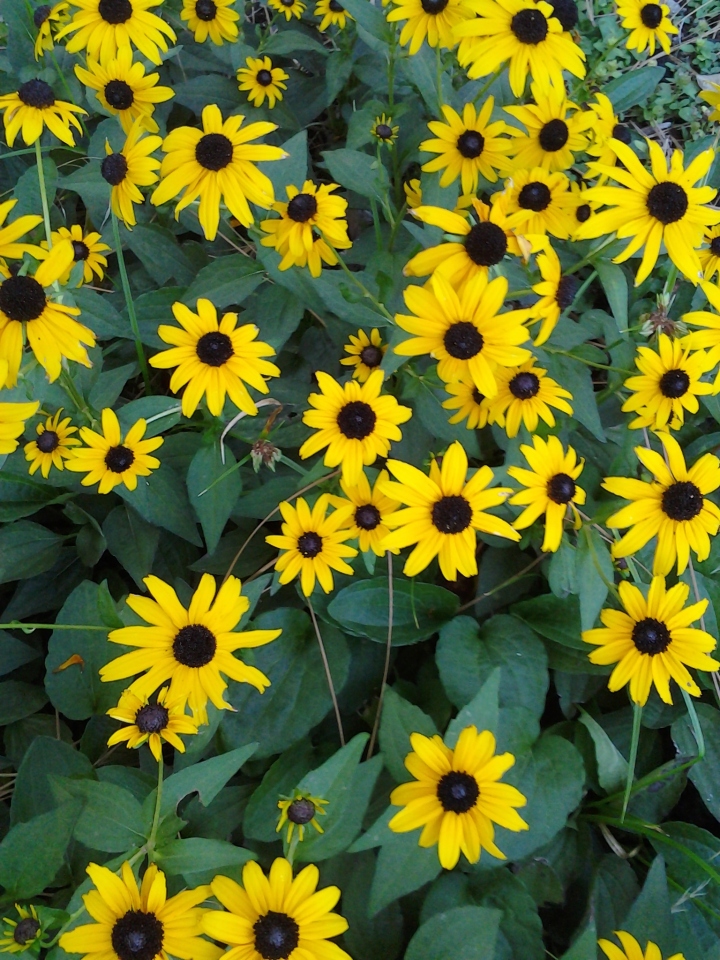 Black-eyed Susan, sunflowers and a few of the late warm season annuals and perennials are still blooming, and a few will continue into autumn. By that time, cool season annuals can move in; and some of the deciduous trees, shrubs and vines that turn color for autumn will be doing so. Realistically though, this can be the leanest time of year for color in the garden. Even some of the foliage that is colorful through spring and summer has faded.
Black-eyed Susan, sunflowers and a few of the late warm season annuals and perennials are still blooming, and a few will continue into autumn. By that time, cool season annuals can move in; and some of the deciduous trees, shrubs and vines that turn color for autumn will be doing so. Realistically though, this can be the leanest time of year for color in the garden. Even some of the foliage that is colorful through spring and summer has faded.
There are certainly plenty of flowers in season now. However, not many are colorful. Honeysuckle vine is pleasantly fragrant as it bloom in random phases until the weather gets cooler, but the flowers are only pale yellowish white. Some melaleuca trees bloom profusely enough to make a mess, but are just as pale, and do not even provide fragrance; although some have pretty light pink flowers. Abelia flowers are pink and abundant, but are really not all that flashy against their bronzy foliage.
Some of the more colorful flowers are not quite as reliable. Princess flower, hibiscus, blue hibiscus and mandevilla certainly can bloom in late summer or autumn, but sometimes bloom earlier than expected, so have nothing left for later. The bright red flowers of blood red trumpet vine are quite impressive, but only if they are not obscured by the accompanying foliage. Some roses bloom in phases as late as the weather will allow, but actually, most are done by now.
Fuchsia and angel’s trumpet likewise bloom in a few phases once they get started, but unlike the many cultivars of roses, they are much more reliable for a late bloom phase. Escallonia blooms late with small but colorful flowers, but only if they have not been shorn in the past few months. Shearing deprives them of the blooming stem tips that they had worked most of the year for.
Butterfly bush, tree mallow, cape plumbago, bee balm and several varieties of sage and salvia are among the most reliable plants for late summer or autumn bloom. Even without multiple bloom phases, they just naturally bloom at the end of their growing season, before winter dormancy.
We have a bit of a second spring here, when it cools down and plants bloom one last time.
LikeLiked by 1 person
That is sort of how it ‘should’ be . . . probably. I have always lived in or near chaparral climate, which is not so forgiving late in summer. The weather is mild, but dry. Exotics are the same that grow elsewhere, but many are tired by the end of summer. Natives are just flat out finished.
LikeLiked by 1 person
Fruits are the most colorful things around at the moment – the Crabapples and Viburnum berries, for example. The Japanese Anemones are looking good, too.
LikeLiked by 1 person
Viburnum berries? I see them in catalogues, but not in landscapes. There are a scant few in the Viburnum tinus, but they are not impressive. (I doubt that species is grown for berries.)
LikeLike
Cranberrybush Viburnum is grown for red berries, and V. nudum for multicolored ones. They may not grow in CA, though.
LikeLiked by 1 person
Even if they do grow here, they are not popular. Snowball bush does nicely here, but is still quite obscure. Viburnum davidii is one that I know does not do well, although I do not know why. Viiburnum tinus is no longer popular, but was years ago, and just never went away. It self sows in many situations.
LikeLiked by 1 person